Stories Worth Reeling In...
Last Updated on September 28, 2023
When it comes to kayaking adventures, safety, and stability are of utmost importance. That’s why kayak outriggers play a vital role in ensuring a secure and enjoyable experience on the water. By attaching outriggers to your kayak, you gain an extra level of stability that can make a significant difference in your overall kayaking performance.
Join me as we explore the various options, consider key features, and help you make an informed decision to enhance your kayaking adventures. Get ready to take your kayaking experience to the next level with the best kayak outriggers out there!
Table of Contents
After extensive research and consideration, I have curated a selection of top-rated kayak outriggers available on the market. These outriggers have been carefully chosen based on their quality, performance, and positive customer reviews.
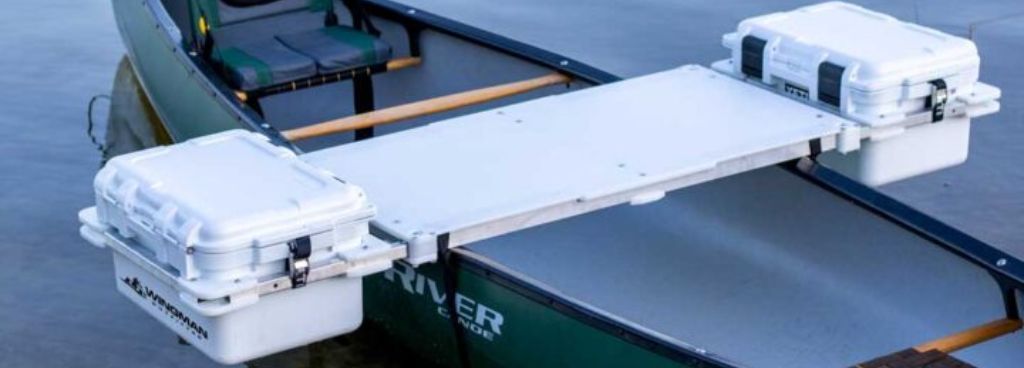
Materials: Aluminum frame, heavy-duty polyester webbing
Length: 20.5 inches (length of the Yeti GoBox™ Gear Cases) (52 cm)
Weight: Unspecified
Wingman’s Cargo Outrigger system is ideal if you need both stability and extra storage capacity. Though designed for canoes, it can be converted to install on a kayak. Once attached, you gain a significant amount of extra stability as well as plenty of additional storage space for your stuff, particularly food and drink.
It’s the most expensive outrigger system on our list, and the coolers must be purchased separately. Any hunter or angler who tries this outrigger will fall in love with it!
Pros:
Cons:
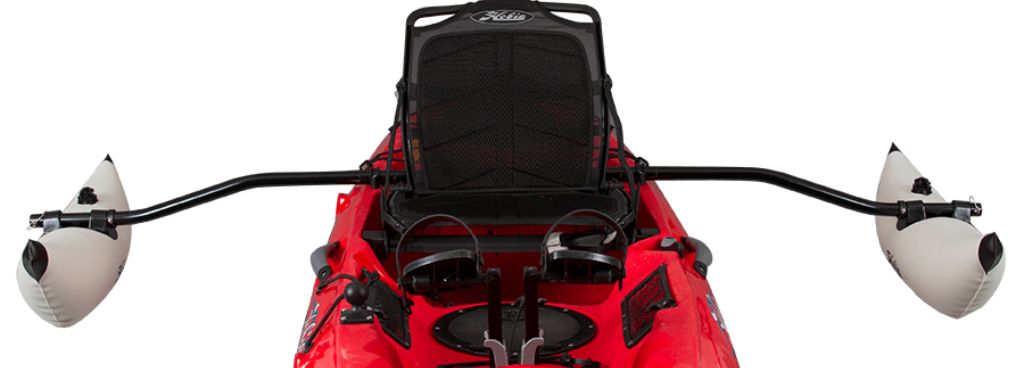
Materials: Aluminum frame, PVC floats
Length: 31.5 inches (80 cm)
Weight: 6 lb (2.5 kg)
This outrigger is ideal for anyone who owns a Hobie kayak. Its inflatable form makes it simple to store and transport, yet all it takes to go paddling is a few fast puffs of breath. It’s rust-resistant, powerful enough to use with a full-size kayak sail, and more than capable of keeping you steady and secure in stormy water thanks to its stout aluminum arms.
The outrigger can be changed with a twist and click between three positions, allowing you to tailor it to your unique paddle length and stroke.
Negative feedback stated that the arm length was insufficient to keep it out of the way of a paddling stroke, and one user had to DIY adapt the system to match their specific Hobie model.
Pros:
Cons:
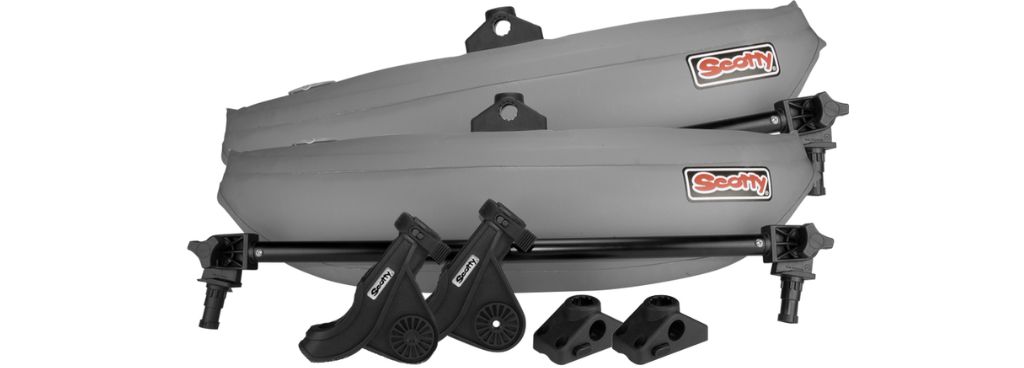
Materials: Anodized aluminum arms, PVC bladder float base
Length: 34 inches (86.36 cm)
Weight: 10 lbs (4.53 kg)
From its worldwide adaptability to its portable, collapsible design and inflated float bases, this outrigger “stabilizer system” is completely user-friendly. They are made in Canada and include sturdy anodized aluminum arms that are strong enough to handle even the roughest paddling conditions.
Each arm provides 30 pounds of buoyancy to the kayak, increasing stability even in turbulent waters. Use it for fishing, hunting, or sailing, and be assured that you will always be stable and upright.
The fact that you can’t alter them means you have to learn how to paddle correctly rather than tailoring them to your paddling stroke.
Pros:
Cons:
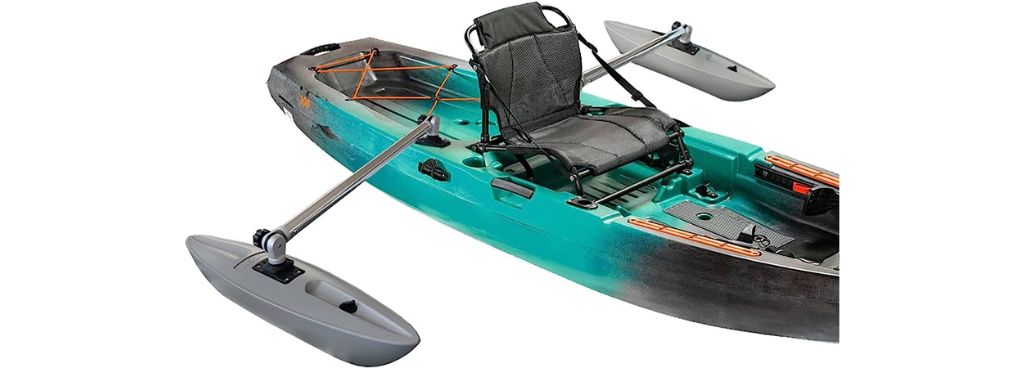
Materials: Aluminum arms, PVC floats
Length: 32 inches (81.28 cm)
Weight: 9 lb (4.29 kg)
With this Brocraft outrigger system, you can keep things simple, sweet, and inexpensive! It is specifically intended for attachment on sit-on-top kayaks, with stainless steel mounting hardware that simply secures in place on your existing frame/mounting options.
Although the arms are not adjustable or extensible, it is lightweight and simple to operate. It’s the ideal outrigger system for a low-cost kayak, transforming it into an ultra-stable fishing platform.
However, several consumers were dissatisfied with the quality of the mounting gear, claiming that it wobbled, failed to connect securely, or broke after a few uses.
Pros:
Cons:
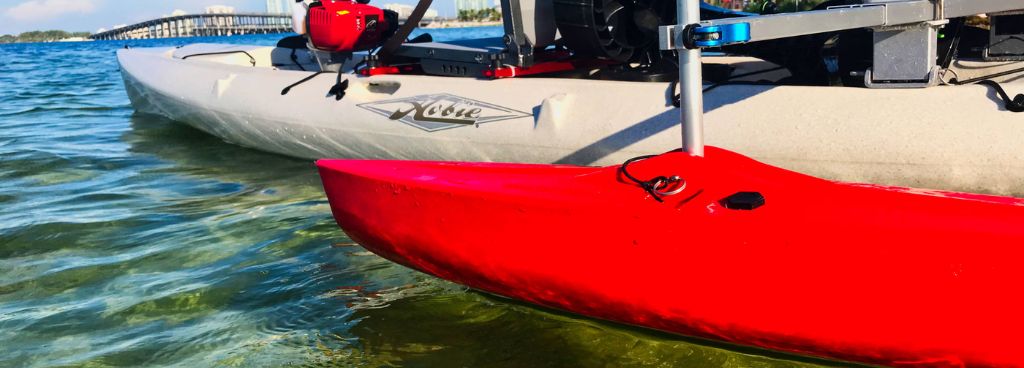
Materials: Aluminum crossbar, sturdy plastic floats
Length: 37 inches (94 cm)
Weight: 15 to 16.5 lbs depending on crossbar size (6.8 – 7.5 kg)
Let’s be clear about one thing about this outrigger: it’s made for canoes, not kayaks. It will require some DIY skills to adjust either the outrigger or your kayak mounting hardware to make it compatible with your kayak.
However, due to its structure, it is the sturdiest and most substantial outrigger on our list. You may actually extend the length of the crossbar by 20 inches on either side to guarantee it doesn’t interfere with your paddling stroke.
On the negative, it’s a little heavier than some of the other mounting systems and will undoubtedly consume a significant portion of your kayak’s weight capacity.
Pros:
Cons:
While kayaks are extremely stable, unless overloaded, they quickly move from side to side, giving the impression that they are unstable. Adding outriggers will increase stability to the point where a capsize occurrence is likely to happen.
Outriggers create a lot of resistance, especially because their hull speed is significantly slower than the main hull’s speed since they are much shorter than the kayak itself.
Stabilizers and outriggers come in a variety of forms depending on the application and are intended to reduce the risk of falling when the combined load and vehicle’s center of gravity are outside the vehicle’s support base. Outriggers raise the wheels of the vehicle off the ground, whereas stabilizers do not.
Investing in high-quality kayak outriggers is an investment in your enjoyment and safety. So, don’t hesitate to explore the recommended options, read customer reviews, and make a well-informed decision.
Get ready to take your kayaking adventures to the next level with the best kayak outriggers available in the market!